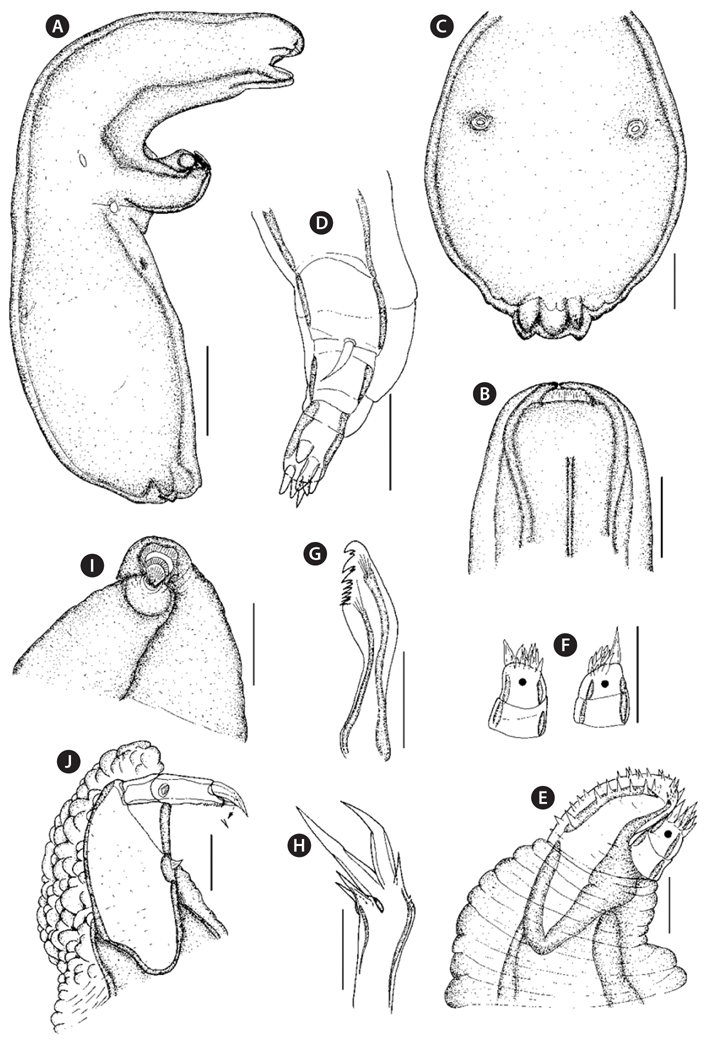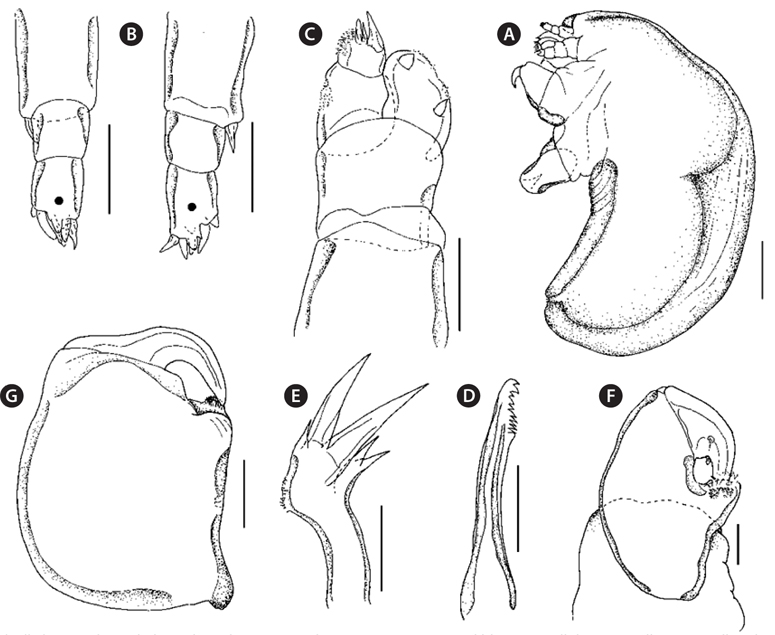



Parabrachiella bera (
The family Lernaeopodidae Milne Edwards, 1840 is the largest group of parasitic copepods, with a long history of synonymies, misidentifications, and status changes among its members (Kabata, 1979). Lernaeopodid copepods currently include about 267 valid species (Boxshall and Halsey, 2004; Boxshall and Walter, 2012); they are most widely adjusted to parasitism (Kabata, 1986) and are highly host-specific (Piaseckiet al., 2010). The genus
The copepod
Order Siphonostomatoida Thorell, 1859Family Lernaeopodidae Milne Edward, 1840Genus Parabrachiella C. B. Wilson, 1915(new Korean genus name: Gyeot-dol-gi-teok-beol-re-sok)
>
Parabrachiella bera (
(new Korean name: Nol-re-gi-gyeot-dol-gi-teok-beol-re)
Brachiella bera Yamaguti, 1939: 566, figs. 225-234.Neobrachiella incurva: Choi et al., 1996: 118, figs. 1, 2.
3♀♀ and 1♂ on a wall of gill rakers from
Female. Cephalothorax (Fig. 1A) subcylindrical, 2.74 mm long, shorter than trunk with lateral curves, its anterior half expanded slightly in girth to from head, covered by subcircular, well delimited dorsal shield (Fig. 1B), with transversely truncated anterior and posteriorly converging lateral margins, slightly subdivided by mid-dorsal groove; at base of cephalothorax subspherical, lateral swellings. Trunk (Fig. 1C) cylindrical in ventral view, 1.33 times (1.55 × 1.21 mm) longer than wide with nearly parallel lateral margin and rounded posterior corners. Posterior part outfitted with a pair of digitiform processes (Fig. 1C). Antennule (Fig. 1D) incompletely 4-segmented; proximal and second segments indistinctly fused; proximal segment unarmed; second segment armed with seta (whip) on medioventral margin; third segment unarmed; distal segment with slightly tapering tip with prominent gibbous and apical armature consisting of five setae and two tubercles. Antenna (Fig. 1E and 1F) biramous, elongate; exopod prominent and longer than endopod, armed with prominent denticulate on rounded tip; endopod 2-segmented, armed apically with 11 spiniform setae. Mandible (Fig. 1G) with dental formular P1, S1, P1, S1, P1, S1, B5. Maxillule (Fig. 1H) biramous, with small endopod and prominent tripartite exopod; endopod composed of short digitiform process surmounted with two setae (small terminal and larger subterminal); exopod tripartite with mediolateral spinulose ornamentation, two large digitiform processes and a short third one, processes ending with conical elongate setiferous processes. Maxillae (Fig. 1I) completely fused together and forming “maxillary trunk”, about one third of cephalothorax length; bulla small with short manubrium. Maxilliped (Fig. 1J) subchelate with robust corpus, covered by thick, wrinkled cuticle and single seta on medial side; long slender subchela with single ventral seta and a row of teeth at base; claw large (constituting almost one-third of subchela), large auxiliary seta at base of claw medially. Thoracic appendages not observed.
Male. Body 0.73 mm long (Fig. 2A), representing male structural type A (Kabata, 1979). Cephalothorax about half of total length, oval in dorsal view and dorsal shield not visible. Trunk subcylindrical; lateral ends tapered and bent posteriorly. Pair of reduced caudal rami. Antennule (Fig. 2B) 3-segmented; proximal segment longest, with seta (whip); apical armature consisting of eight spiniform setae. Antenna (Fig. 2C) biramous, elongate; sympod cylindrical, unarmed; bulbous 1-segmented, exopod distinctly shorter than endopod, armed with two tubercles endopod 2-segmented with proximal segment with denticulate pad; distal segment with three spiniform setae and deticulate pad. Mandible (Fig. 2D) with dental formula P1, P1, S3, B5. Maxillule (Fig, 2E) similar to female although more slender; endopod terminating with two equal small setae. Maxilla (Fig. 2F) subchelate (made of strong thick cuticle) with robust corpus and strong subchela; corpus unarmed; subchela with well delimited, powerful claw and slightly shorter cylindrical shaft; closed subchela partly hiding tip of claw behind medial outgrowth of corpus with scattered denticles; claw with small seta and spine medioventrally. Maxilliped (Fig. 2G) subchelate, similar in structure to maxilla but stronger in appearance; subchela very robust with claw positioned at right angle to shaft, scattered spinules distolaterally; claw with broad base and slender tip. Thoracic appendages not observed.
Prevalence was recorded as 27.2% .
The number of species of
Choiet al. (1996) reported that the same lernaeopodids were collected from the gills of

